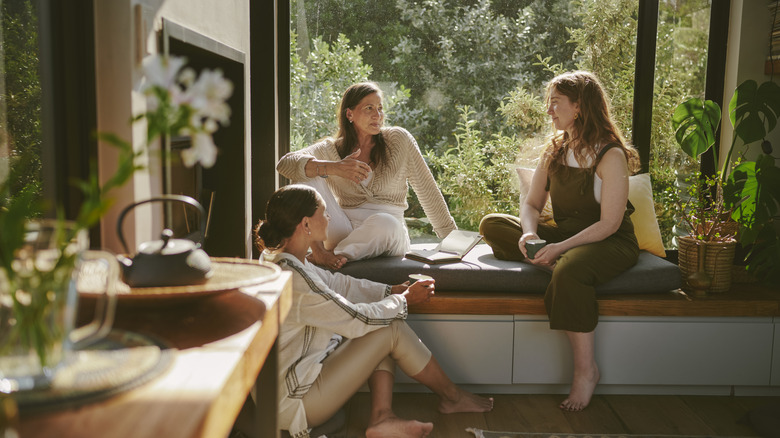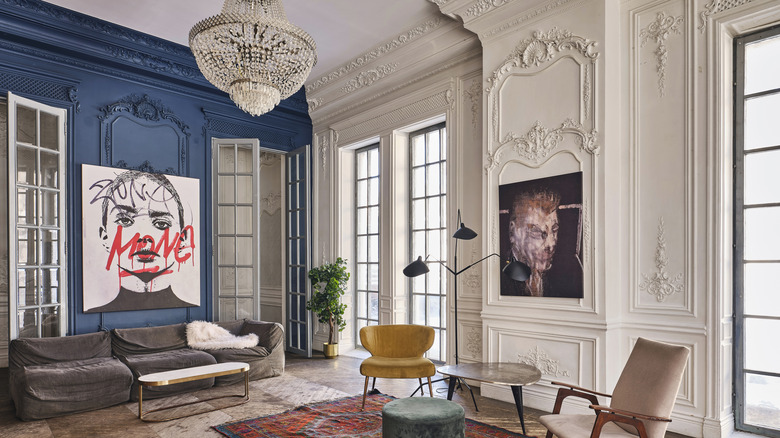The Three-Word Concept Joanna Gaines Swears By When Designing A Room
We may receive a commission on purchases made from links.
It's easy to get lost watching hours of Joanna Gaines designing beautiful spaces, especially when she makes it look so effortless that we're convinced we can achieve the same results ourselves. While not everyone is gifted with the unique talent and eye for style that Gaines possesses, she has shared plenty of useful insight into her approach over the years that can be applied to our own home renovations. There are plenty of specific tricks to decorate your home like Joanna Gaines, but the best place to start is by focusing on the three magic words that she always relies on when setting the foundation for her beautiful interiors: feel, function, and style.
Gaines revealed this three-word concept in her MasterClass, sharing that at the beginning of every project, she asks her clients how they want the home to feel, how it should function, and what kind of style it is that they're aiming towards. It sounds simple — perhaps even obvious — however, homeowners often focus on these key aspects individually. For instance, maybe in the past you've been so zeroed in on getting a specific, trendy style that you end up with a space that doesn't feel functional, or on the other hand, you're so strict about the functional features that it leaves the design lacking style and personality. When you bring these three concepts together, and really evaluate what each word means to your design, you can start building a Gaines-level interior makeover for your space.
Start by determining feel and function
Gaines loves this three-word concept because it has people focus on their personal needs and wishes, rather than trying to recreate spaces they've seen. When asking yourself what your home design should feel like, it's not about style or aesthetics, it's about the atmosphere you want to create. Maybe you want a reading room that feels cozy and nostalgic, or a kitchen and dining area that feels sophisticated and social. Taking a personal approach is always helpful, whether you're an empty nester who envisions a home your children will always feel welcome to return to, or a city dweller hoping for a space where friends gather and exciting memories are made. When imagining the feeling of your space, try to engage your senses in the process — maybe you see lots of artwork, or taste and smell your morning coffee.
Once you've nailed down the feeling you want in your space, move on to Gaines' next step of exploring how you want it to function. If you need to transform a single space into multiple functional rooms, identify each of those functions and consider what you'll need to accommodate each. Overall aspects of function for a space might be work, play, or rest, while more specific functions might include privacy, focus, or seating space for gatherings. These ideas often tie in with the feeling you've defined for the home, so if you get stuck, think about what you envisioned and what that will require.
Nail down your style
Among Gaines' three-word concept, style is the final piece of the puzzle. One of the biggest mistakes when finding home design inspiration is forgetting to define your style — without this step, you can end up with a room that lacks personality and just looks like a cluttered mess of various trends. Gaines in particular determined her personal style many years ago when she was inspired by the mix of lush, earthy farmland and industrial silos she saw during a road trip to New Mexico. This led her to commit to an industrial farm style, a look which she refers back to in all of her interior designs. A clear definition of the style you want for a room provides you with a touchpoint to rely on throughout the design process so you can make decisions that will create a cohesive look.
There are endless styles to explore, and you might already have plenty of Pinterest boards full of different aesthetics that inspire you. Take advantage of all the inspiration you've gathered and see if there are any common threads that can lead you to your personal style. Maybe you tend to lean towards coastal color palettes, mid-century modern furniture, or traditional details — if you see a repetitive concept, it could help indicate the specific style that should ground your design.


